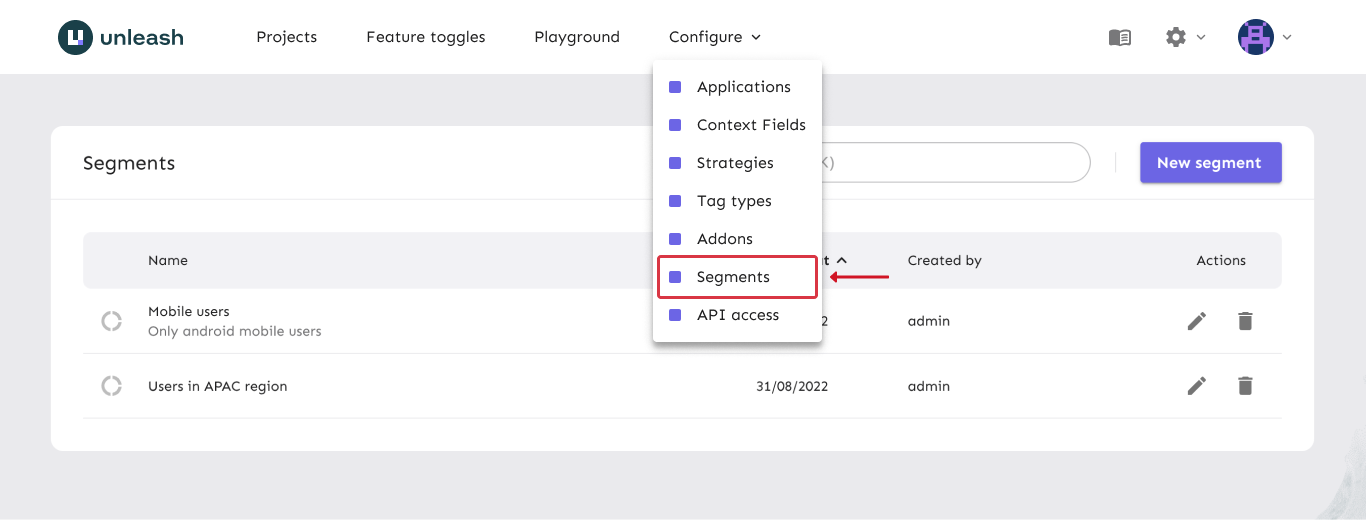Segments
Version: 4.13+ for Pro and Enterprise.
Version: 5.5+ for Open Source.
A segment is a reusable collection of strategy constraints. Like with strategy constraints, you apply segments to feature flag activation strategies.
You can apply the same segment to multiple activation strategies. If you update the segment, the changes will affect every strategy that uses that segment.
Segments let you create user groups based on data available in the Unleash context. These groups can be as simple or as complex as you want to make them. You could, for example, use segments to target:
- Users in a specific region
- Users on a specific device type
- Users who signed up before a specific point in time
- ... Or any combination of the above.
Because segments stay in sync across strategies, any changes will propagate to all the activation strategies that use them. This also makes them ideal for use cases such as activating or deactivating multiple feature flags at the same time. In other words, you can use segments to
- release one or more new features at a specified time
- create events with start and end times and guarantee that features will only be active during that period
Segments can be global or scoped to a specific project. If a segment is scoped to a single project, it can only be used in that project and it adheres to that project's change request settings.
Structure and evaluation
Segments are collections of strategy constraints. To satisfy a segment, all the constraints in the collection must be satisfied.
If an activation strategy has a segment and additional constraints applied, the segment and the strategies must all be satisfied. Similarly, if an activation strategy has multiple segments, then they must must all be satisfied.
Segment limits
In theory, you could create segments with a thousand constraints, each with a million values. But this wouldn't scale well, so there are limitations in place to stop you from doing this. Unleash enforces the following limits on use of segments:
-
If you're on a Pro plan:
A segment can have at most 250 values specified across all of its constraints. That means that if you add a constraint that uses 10 values, you will have 240 more values to use for any other constraints you add to the same segment.
-
If you're on an Enterprise plan:
A segment can have at most 1000 values specified across all of its constraints. That means that if you add a constraint that uses 70 values, you will have 930 more values to use for any other constraints you add to the same segment.
By default, you can apply at most 5 segments to any one strategy. Separate strategies (even on the same feature) do not count towards the same total, so you can have two strategies with 5 segments each.
You can configure segment limits with environment variables.
A note on large segments
Segments are just constraints, so any limitations that apply to constraints also apply to segments. See Using Unleash with large constraints for a more guidance.
Creating, updating, and deleting segments
Currently in development, Unleash will soon count segments as being in use when they are used in change requests.
Segments can be created, edited, and deleted from the segments page in the admin UI or via the API (see the segments API documentation).
A segment that is in use cannot be deleted. If you'd like to delete a segment that is in use, you must first remove the segment from all the activation strategies that are currently using it. If a segment is in use by an archived flag, you must either unarchive the flag and remove the segment or delete the flag entirely before the segment can be deleted.
A segment that is in use in multiple projects can not be turned into a project-level segment. Further, a segment that is in use in project A cannot be turned into a project-level segment in project B.
